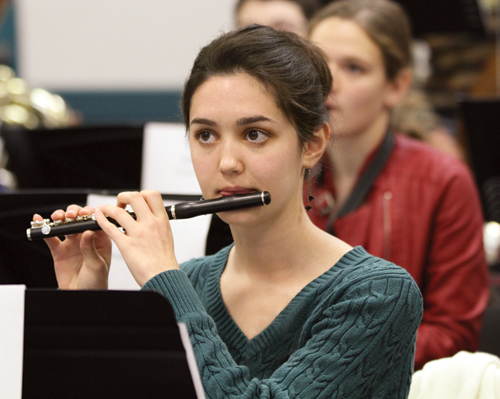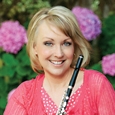
Playing the piccolo in an ensemble offers a set of challenges somewhat different from playing the flute. The piccolo transposes at the octave, which means the notes sound one octave higher than written. Learning to finger in one octave while a higher note is sounding takes some practice. Since the ear tends to perceive high sounds as being louder, novice players sometimes play too loudly, and, for some, playing these top notes is a scary proposition. Understanding the role of the piccolo in the orchestration will help new players meet these issues with confidence and artistry. Because the piccolo player is usually the only one playing that instrument in the group, it automatically takes more of a solo role in the ensemble, mirroring that of the tuba player at the low end of the tessitura.
Doubling Tuned Percussion
It is a common orchestration practice to have the piccolo double with the glockenspiel, vibraphone, xylophone or marimba. This voicing adds definition to the percussion sounds. When performing this doubling, remember the percussion instruments are fixed in their pitch. It is helpful to know where the percussion instruments pitch is set (A=440, 441 or 442). Brief moments doubling xylophone in “The Infernal Dance” of Stravinsky’s Firebird come to mind, as well as some tricky passages with glockenspiel in Puccini’s opera Turandot.
Doubling Brass
There are many places in orchestral literature where the piccolo doubles a French horn line at the octave, or punctuates a muted trumpet line. When brass instruments use a mute, the tendency is for pitch to go slightly higher, so be careful to adjust if this is the case. Bernstein’s Candide Overture after rehearsal 120 is a good example of this doubling with the horn. Be aware that the doubling is actually two octaves apart once with the octave transposition of the piccolo.
Doubling Strings
The piccolo also is often added on top of the tutti string family. If a part is marked 8va, be sure to follow that direction because the piccolo is adding an octave to the orchestration. 8va markings are usually not optional. It takes courage to play higher than everybody else, but it feels wonderful to soar above the texture. A classic piccolo passage from the “Overture” to Semiramide (just past letter G) is commonly thought of as a solo for this reason even though the piccolo actually is doubling the tutti violin section.
Doubling Woodwinds
Blend and balance are critical when doubling other woodwind instruments since each instrument may have the leading solo line. Pay attention to whether the piccolo has the harmony or lead melodic line to choose an appropriate dynamic level. Of course, supporting harmony lines would be slightly less predominant than the melodic line. Take care with vibrato, especially when doubling with the clarinet which does not vibrate. As always be sensitive to pitch because even if a tuner says a note is perfect, there are usually adjustments needed to match colleagues. There are countless passages in the literature where piccolo doubles the Eb clarinet, flute, solo oboe, or principal bassoon. Each situation calls for a different recipe for good blend and balance.
Solving Problems
Since the piccolo transposes up an octave, learning to read one note and having it sound an octave higher takes some time. Practice switching from piccolo to flute and back again to get your sonic bearings. Play a few long tones on the piccolo beginning on the B in the staff and then switch to flute playing the same long tones in the flute’s second octave. Try to match the dynamic from piccolo to flute. Then repeat starting on the B in the middle octave on the piccolo which will sound the same as the top octave of the flute. Carefully comparison of the piccolo to the flute, helps players become more comfortable with the automatic octave transposition.
When learning the highest register on the piccolo, start slowly. Begin on the middle octave B, playing to the C and then back. Repeat adding one more chromatic note.
Embouchure
There are a few subtle differences between flute and piccolo embou-chures. The aperture must be smaller when playing piccolo in order to produce a controlled beautiful tone. Be sure to set the instrument slightly higher on the lower lip than the flute setting so that the air column can reach the back wall of the embouchure hole. (The smaller size of the instrument requires this little adjustment). It helps to remind yourself to bring the top lip slightly more forward than you are used to for the flute, almost like blowing a kiss to somebody across the room, to help angle the air properly. Make sure to keep the instrument parallel to the bottom lip. A slight angle to the instrument is preferred instead of holding it marching band straight.
Take special care to note any excess tension in the lips. If the corners of the lips feel as though they are squeezing back and together like a smile, relax them. Think of saying the word pure to help bring those lip corners toward the canine teeth and into a position that is less gripped. If the top lip pushes down toward the bottom lip, make an immediate adjustment. This usually produces buzzing like the Bronx cheer. For this problem, add height to the aperture.
All of these adjustments provide more tonal control and take away that initial tendency to have a wild and untamed tone on the piccolo. Remember, it is a smaller instrument, so embouchure adjustments will also be tiny, and a little often goes a long way.
Air
Many novice piccolo players over-blow on the piccolo. Try to resist the temptation to drive the tone with a lot of air because that produces sounds that are harsh and gritty. Lift the tone and allow it to float through the texture. Since the instrument is smaller, think of using a firm, concentrated air stream featuring speed and support, rather than using a large quantity or volume of air. Lifting the rib cage and sternum at the ends of the phrases to control the air helps keep the pitch from dropping. Small embouchure movements forward at the ends of notes will also shape tapers and give elegant releases.
It is critical to understand the piccolo’s role in different orchestral situations. Through careful practice, new piccolo players will enjoy their new role in the ensemble texture.






